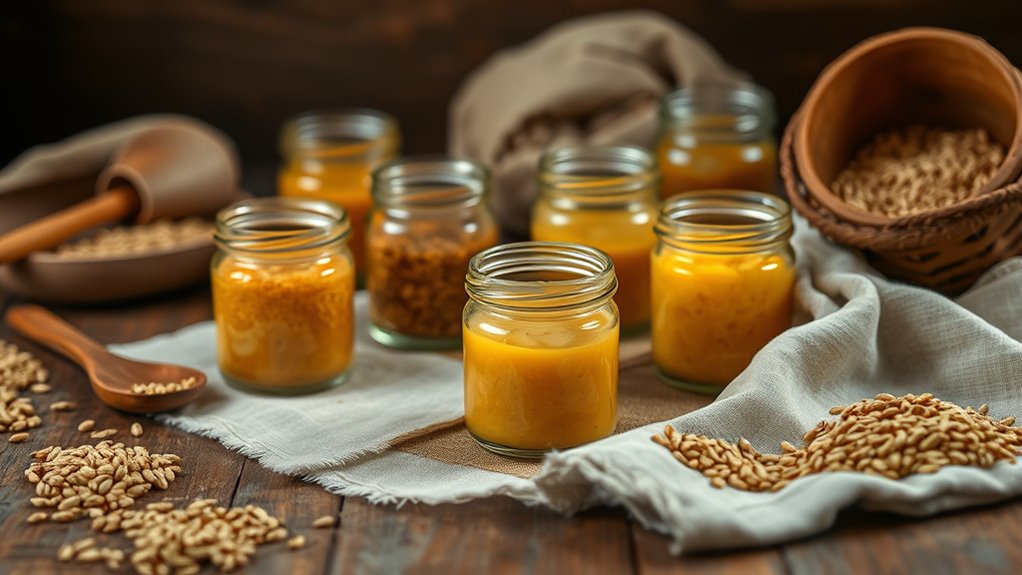Regional yeast cultures are essential to Italian baking because they give each bread a unique flavor, texture, and aroma rooted in local traditions and environment. These cultures, often wild and maintained over generations, capture the essence of their region’s ingredients and climate. They influence long or quick fermentation techniques and create breads like pane toscano or focaccia genovese that reflect Italy’s rich baking heritage. Discover more about how these traditions shape Italy’s beloved breads.
Key Takeaways
- Regional yeast cultures define the distinct flavors and textures of traditional Italian breads, reflecting local terroir and ingredients.
- Traditional fermentation techniques, passed down through generations, utilize wild yeasts and natural processes unique to each region.
- Sourdough starters cultivated locally develop complex, tangy profiles that embody regional environmental influences.
- The choice of yeast culture influences bread aroma, taste, and overall identity, preserving regional culinary heritage.
- Fermentation practices in Italy serve as a sensory link to history, culture, and the character of specific regional baked goods.

Italy’s rich baking traditions are deeply rooted in regional yeast cultures that give each bread its distinct flavor and character. These cultures aren’t just about adding leavening; they’re the foundation of unique fermentation techniques that shape the taste and texture of Italian baked goods. When you explore different regions, you notice that each has its own way of cultivating and maintaining these yeast cultures, which directly influence flavor development. By understanding these methods, you gain insight into how Italy’s diverse bread offerings achieve their signature qualities.
In many parts of Italy, baking relies on natural fermentation processes passed down through generations. These techniques often involve fermenting dough with wild yeasts present in the environment or in locally sourced ingredients. For example, in Tuscany, bakers use long fermentation times that allow natural yeasts to develop complex flavors. This slow process enhances flavor development, creating breads with nuanced, layered tastes that can’t be replicated with commercial yeasts. Meanwhile, in Naples, the focus is on rapid fermentation to produce the light, airy structure of traditional pizza dough, but even here, regional yeast cultures influence subtle flavor nuances.
Italian regions cherish unique fermentation methods, creating breads with distinct, layered flavors rooted in local yeast cultures.
The fermentation techniques employed in various regions aren’t just about leavening; they’re about coaxing the best possible flavors from the ingredients. In northern Italy, bakers might use a sourdough starter that’s been cultivated for decades, which imparts a tangy complexity to their bread. These starters are living cultures, often maintained with specific local ingredients, and they develop distinctive qualities over time. Through careful management of fermentation conditions—temperature, hydration, and timing—bakers can enhance flavor development, resulting in breads that carry the essence of their region. Proper fermentation is essential for unlocking the full potential of regional ingredients and techniques.
Understanding the role of regional yeast cultures also reveals how they contribute to the identity of Italian bread. Each culture’s unique fermentation techniques influence the aroma, taste, and even the texture of the final product. By preserving these traditional practices, bakers ensure that their bread reflects the terroir of their region, much like wine or cheese. Whether it’s the chewy, rustic pane toscano or the fragrant, airy focaccia genovese, these breads owe their character to the specific yeast cultures and fermentation methods that have been refined over centuries.
In essence, regional yeast cultures aren’t just about leavening; they’re about crafting a sensory experience rooted in local history and environment. Your appreciation for Italian bread deepens as you recognize how fermentation techniques and flavor development intertwine, revealing the rich tapestry of Italy’s baking heritage.
Frequently Asked Questions
How Do Regional Yeast Cultures Influence Bread Texture?
Regional yeast cultures markedly influence bread texture by shaping fermentation dynamics, which affect how the dough develops and rises. You’ll notice that these cultures contribute unique regional flavor profiles, adding complexity to the bread’s taste. As you bake, the specific yeast strains interact with local ingredients, creating distinct textures—crisp crusts, chewy interiors—that reflect the region’s culinary traditions and fermentation nuances.
Are Regional Yeast Cultures Sustainable and Eco-Friendly?
Sustainable and eco-friendly practices are possible with regional yeast cultures, as they promote sustainable agriculture by reducing reliance on commercial yeasts and minimizing environmental impact. You can support ecological balance by choosing local, naturally cultivated cultures, which often require less energy and resources. This approach helps preserve biodiversity, lowers carbon footprints, and fosters a healthier environment, making regional yeast cultures a smart, sustainable choice for eco-conscious bakers like you.
Can Regional Yeast Cultures Be Adapted for Gluten-Free Baking?
You can definitely adapt regional yeast cultures for gluten-free baking through gluten free fermentation and yeast adaptation. By selecting and cultivating the right wild yeasts, you help guarantee the flavors develop beautifully without gluten. Experiment with local yeasts, adjusting fermentation times, and maintaining the culture’s health. This approach allows you to create authentic, flavorful gluten-free bread that benefits from the unique qualities of regional yeast cultures.
What Are the Health Benefits of Regional Yeast Cultures?
Imagine the bustling fermentation process as a vibrant dance of microbial diversity, where regional yeast cultures lead the way. By embracing these local strains, you can boost your gut health, strengthen your immune system, and improve digestion. The unique probiotics from regional yeasts support overall well-being, making your baked goods not just delicious but also beneficial. Immerse yourself in this natural, health-boosting tradition and savor the wholesome benefits.
How Long Do Regional Yeast Cultures Typically Last?
Regional yeast cultures typically last for several years with proper preservation techniques. Their fermentation longevity depends on how well you maintain them—regular feeding and controlled storage are key. To guarantee they stay active, you might store them in a cool, dry place or refrigerate. With attentive care, your regional yeast cultures can continue to ferment and enhance your baking projects for many seasons.
Conclusion
By embracing regional yeast cultures in Italian baking, you unveil flavors so authentic and vibrant, they’ll transport your taste buds straight to Italy’s heart. Every loaf becomes a masterpiece, bursting with centuries of tradition and magic that no commercial yeast can match. Once you experience these cultures, you’ll realize your baking can reach legendary status—turning simple bread into an unforgettable culinary adventure. Get ready to revolutionize your baking and leave everyone wondering how you achieved such extraordinary results!









